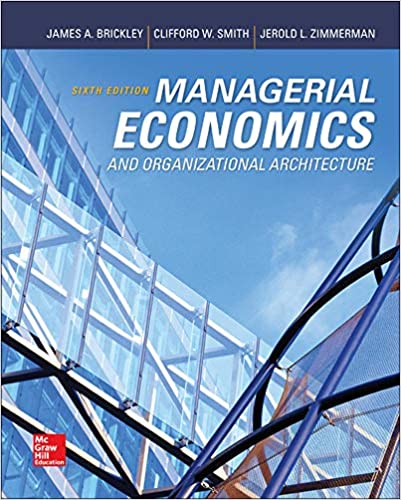
Managerial Economics & Organizational Architecture 6th Edition by James Brickley , Clifford Smith ,Jerold Zimmerman
Edition 6ISBN: 978-0073523149
Managerial Economics & Organizational Architecture 6th Edition by James Brickley , Clifford Smith ,Jerold Zimmerman
Edition 6ISBN: 978-0073523149 Exercise 27
For simplicity, throughout this problem, assume labor ( L ), capital ( K ), and quantity produced ( Q ) can be infinitely divided-that is, it is fine to hire 3.3 workers, rent 4.7 machines, and/or produce 134.2 units. Answer the following questions, assuming the production function for DurableTires Corp. is
 where Q is the quantity of tires produced, L is the number
where Q is the quantity of tires produced, L is the number
of workers employed, and K is the number of machines rented.
a. What is the quantity of tires produced when the company employs 64 workers and 36 machines
b. What are the average product of labor ( L ) and the average product of machines ( K ) when the input mix is the one given above Clearly and concisely, please explain how you would interpret these numbers.
c. Continue to assume the input mix given above: What is the marginal product of labor ( L ), if the number of workers is increased by 1 unit What is the marginal product of capital ( K ), if the number of machines is increased by 1 unit, instead Clearly and concisely, please explain how you would interpret these numbers.
d. Does DurableTires' production function display increasing, decreasing, or constant returns to scale Explain. Would your answer change, if the production function were
 How Explain.
How Explain.
e. Does DurableTires' production function display increasing, decreasing, or constant returns to labor Explain. Would your answer change, if the production function were
 How Explain.
How Explain.
 where Q is the quantity of tires produced, L is the number
where Q is the quantity of tires produced, L is the numberof workers employed, and K is the number of machines rented.
a. What is the quantity of tires produced when the company employs 64 workers and 36 machines
b. What are the average product of labor ( L ) and the average product of machines ( K ) when the input mix is the one given above Clearly and concisely, please explain how you would interpret these numbers.
c. Continue to assume the input mix given above: What is the marginal product of labor ( L ), if the number of workers is increased by 1 unit What is the marginal product of capital ( K ), if the number of machines is increased by 1 unit, instead Clearly and concisely, please explain how you would interpret these numbers.
d. Does DurableTires' production function display increasing, decreasing, or constant returns to scale Explain. Would your answer change, if the production function were
 How Explain.
How Explain.e. Does DurableTires' production function display increasing, decreasing, or constant returns to labor Explain. Would your answer change, if the production function were
 How Explain.
How Explain.Explanation
a. Calculate the quantity of tyres produ...
Managerial Economics & Organizational Architecture 6th Edition by James Brickley , Clifford Smith ,Jerold Zimmerman
Why don’t you like this exercise?
Other Minimum 8 character and maximum 255 character
Character 255


